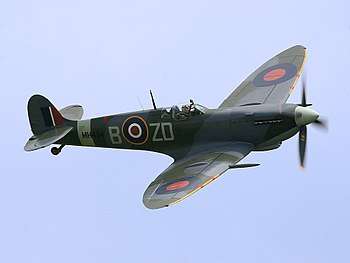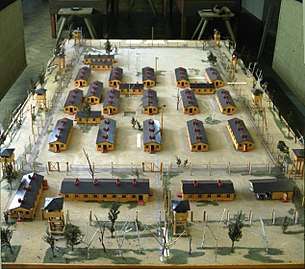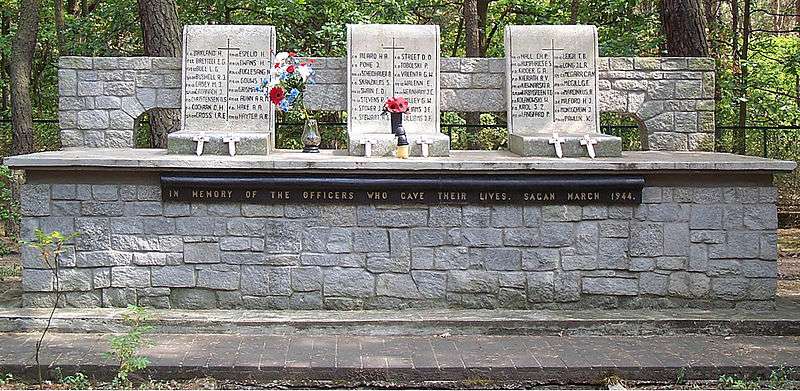Al Hake
Al Hake (30 June 1916 – 31 March 1944), was an Australian Supermarine Spitfire pilot who was taken prisoner during the Second World War. He is notable for the part he took in the 'Great Escape' from Stalag Luft III in March 1944 and as one of the men recaptured and subsequently shot by the Gestapo.
Hake, Albert Horace | |
|---|---|
 Spitfire LF Mk IX, MH434 being flown by Ray Hanna in 2005. | |
| Birth name | Hake, Albert Horace |
| Nickname(s) | Al |
| Born | 30 June 1916 Sydney, Australia |
| Died | 31 March 1944 (aged 27) between Halbau and Görlitz, Germany |
| Buried | Poznan Old Garrison Cemetery, Poland |
| Allegiance | |
| Service/ | |
| Years of service | 1941–1944 |
| Rank | Pilot Officer |
| Service number | 403218 |
| Unit | No. 72 Squadron RAF |
| Battles/wars | World War II |
| Awards | Mentioned in Despatches |
| Relations | Noela Aundree Lillian Hake (wife) |
Pre-war life
Hake was born on 30 June 1916 close to Sydney's Parramatta River and with his brother Les spent much of his time on the water on homemade rafts and boats including a night adrift in Sydney Harbour with the authorities searching for them.[1] He was recognized at school for his talent in technical drawing and metal working, this gained entry to Sydney Technical High School for him. He was a serious student and moved directly from school into a good position with an air conditioning company, his ambition at that time was to own his own "air con" company.[2][3]
War service
Following the outbreak of war in Europe Hake joined the Royal Australian Air Force Reserve in July 1940 and answered immediately to call-up on 4 January 1941.[4][5] He wished to fly and his instructors recommended that had the aptitude to train for aircrew so after basic training he was posted to Wagga Wagga where all Australian aircrew candidates were screened for aptitude. While here he married his girlfriend Noela Horsfall. He learned to fly and attained the required grade and graduated on 20 August 1941.[6] On 7 September 1941 he joined a group of airmen embarking aboard the ocean liner "Athlone Castle" for England to continue his training with No, 53 Operational Training Unit at Llandow in Wales flying Supermarine Spitfire aircraft. He completed training on 14 January 1942 amongst the top 3 pilots on the source.[7]
In January 1942 he joined No. 72 Squadron RAF flying Supermarine Spitfire's from RAF Biggin Hill carrying out operational fighter sweeps and bomber escort missions over the English Channel occupied France and the Netherlands.
Prisoner of war

In major fighter action code named "Circus 119" on 4 April 1942 ten Supermarine Spitfires were shot down in combat with a large group of Luftwaffe Focke-Wulf Fw 190s, Hake's own aircraft Supermarine Spitfire Mark Vb (serial number "AB258") was shot up badly by enemy fighters before anti-aircraft fire damaged his propeller also setting his aircraft on fire.[8][9] He baled out and landed by parachute slightly wounded and burned beside a unit of the German Army.[10] Sergeant Hake noted the respect shown by the Germans to a Spitfire pilot and their assumption that he was an officer so he played along and throughout his imprisonment was believed by the Germans to be an officer.[11]
He became prisoner of war No. 6 held at Stalag Luft III in the province of Lower Silesia near the town of Sagan (now Żagań in Poland). Hake occupied himself with a vegetable patch during the early stages of his captivity but soon his talents at making and fixing things brought him into the escapers group where he developed a production line system to hand make compass equipment for escapers.[12] He became a forger of Nazi travel documents and recovering from a mild bout of diphtheria in mid-September 1942 he set up the compass factory in his room in the northern end of Block 103 melting pieces of broken Bakelite phonograph record to be fixed to pieces of razor blade which was duly magnetized. Over 200 were produced.[13][14][15][16]
'Great Escape'
He was one of the 76 men who escaped the prison camp on the night of 24–25 March 1944, in the escape now famous as "the Great Escape". When the Germans discovered the escape they began extensive well planned manhunts. Al Hake was one of the prisoners recaptured relatively quickly - on the afternoon of 27 March 1944 he and his escape partner Johnny Pohe were brought into the cells at Görlitz suffering the effects of a tough journey in the freezing cold weather, both were frostbitten,[17] Hake the worst of the two.[18] Nineteen recaptured officers were loaded into a lorry the following day and moved to Görlitz prison under Gestapo control. Here the numbers of recaptured officers grew until thirty-five were held there.[19] The prisoners were threatened with death and interrogated harshly but not physically. On 30 March 1944 two of the survivors saw three large sedans with ten Gestapo agents collect six officers, Ian Cross, Michael James Casey, George Wiley, Tom Leigh, John Pohe and Al Hake struggling to walk on his frostbitten feet.[20][21][22][23][24] they were not seen again, their cremation urn labels stated that they died on 31 March 1944 and had been cremated at Görlitz.[25][26][27]
He was one of the 50 escapers executed and murdered by the Gestapo.[28][29][30][31][32][33] Originally cremated and buried at Sagan, he is now buried in part of the Poznan Old Garrison Cemetery.[34][35]
Post-war investigation found that a Gestapo agent named Lux led the squad who shot the group of six recaptured airmen beside the autobahn near Halbau on the instructions of a senior officer named Scharpwinkel.[36][37]
He was amongst the 47 murdered officers named in the British and Commonwealth press when the story became public knowledge on or about 19–20 May 1944[38][39] The Glasgow Herald of 19 May 1944 published an early list naming several officers including Hake[40] He and the other Australians were named in an article in the Canberra Times newspaper on 28 February 1946.[41]
Al Hake was promoted to warrant officer either in captivity or more likely posthumously.[42]

Awards
Mentioned in despatches for conspicuous gallantry as a prisoner of war (none of the other relevant decorations then available could be awarded posthumously). It was published in a supplement to the London Gazette on 8 June 1944.[43][44]
Other victims
The Gestapo executed a group of 50 of the recaptured prisoners representing almost all of the nationalities involved in the escape. Post-war investigations saw a number of those guilty of the murders tracked down, arrested and tried for their crimes.[45][46][47]
| Nationalities of the 50 executed |
References
Notes
- Google Books - Vance, p.133 Hake biography
- Vance (2000), p.133-134
- Australian Government Roll of Service - Albert Horace Hake
- Vance (2000), p.134
- Australian Government Roll of Service - Albert Horace Hake
- Vance (2000), p.134
- Vance (2000), p.135
- Docherty (2009), p.242
- Google books, Docherty, p.242-243 on line
- Franks (1998), p.19-20
- Vance (2000), p.136
- Docherty (2009), p.242-243
- Read (2012), p.8-9
- Burgess (1990), p.36-38
- Andrews (1976), p.206
- Vance (2000), p.165-167
- Australian Defence website - Warrant Officer A H Hake
- Vance (2000), p.244-245
- Andrews (1976), p.49
- Vance (2000), p.264
- Read (2012), p.221-222
- Australian Defence website - Warrant Officer A H Hake
- Andrews (1976), p.49
- Burgess (1990), p.159
- Pegasus Archive - 50 murdered escapers
- Andrews (1976), p.189 and 206
- Burgess (1990), p.271
- Australian War Memorial - Albert Horace Hake
- RSL website - with good photo of AH Hake
- Vance (2000), p.289
- Andrews (1976), p.206
- Burgess (1990), p.271
- Read (2012), p.305
- Commonwealth War Graves Commission casualty – Al Hake
- Pegasus Archive - 50 murdered escapers
- Read (2012), p.240
- Andrews (1976), p.186
- Western Morning News, Dundee Courier and Yorkshire Post, 20 May 1944
- Ottawa Journal, 20 May 1944, p.17 – listing murdered officers
- Glasgow Herald page on line - article naming officers
- Canberra Times - page on line
- Australian Defence website - Warrant Officer A H Hake
- "No. 36544". The London Gazette (Supplement). 2 June 1944. pp. 2642–2643.
- AWM website - RAAF card recording MID award to A H Hake
- Read (2012), p.295
- Vance (2000), p.310
- Andrews (1976), p.188 and 199
Bibliography
- Tom Docherty (2009). Swift to Battle, No. 72 Fighter Squadron, Volume 1. Pen and Sword. ISBN 1844158292.
- Allen Andrews (1976). Exemplary Justice. Harrap. ISBN 0-245-52775-3.
- William Ash; Brendan Foley (2005). Under the Wire: The Wartime Memoir of a Spitfire Pilot, Legendary Escape Artist and 'cooler King'. Bantam. ISBN 978-0-593-05408-6.
- Paul Brickhill (2004). The Great Escape. W.W. Norton & Company. ISBN 978-0-393-32579-9.
- Alan Burgess (1990). The Longest Tunnel: The True Story of World War II's Great Escape. Naval Institute Press. ISBN 978-1-59114-097-9.
- Albert P. Clark (2005). 33 Months as a POW in Stalag Luft III: A World War II Airman Tells His Story. Fulcrum Pub. ISBN 978-1-55591-536-0.
- Arthur A. Durand (1989). Stalag Luft III: The Secret Story. Patrick Stephens Limited. ISBN 978-1-85260-248-2.
- Sean Feast (2015). The last of the 39-ers. Grub Street. ISBN 978-1909166158.
- Norman Franks (1998). RAF Fighter Command Losses. Midland Counties. ISBN 1-85780-075-3.
- Cato Guhnfeldt (2009). Spitfire Saga Volume II. Wings Publishing. ISBN 978-8205452978.
- Paul Read (2012). Human Game: Hunting the Great Escape murderers. Constable. ISBN 978-1472112620.
- Jonathan F Vance (2000). A Gallant Company. Pacifica Military. ISBN 978-0-935-55347-5.
- Frank Walker (2015). Commandos:Heroic and deadly ANZAC raids. Import Aus. ISBN 978-0733631535.[1]
- Marilyn Walton (2014). From Interrogation to Liberation. AuthorHouse. ISBN 1491846887.
External links
- Project Lessons from the Great Escape (Stalag Luft III), by Mark Kozak-Holland. The prisoners formally structured their work as a project. This book analyses their efforts using modern project management methods.